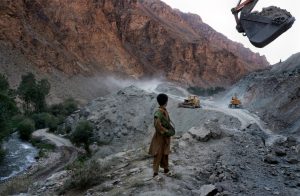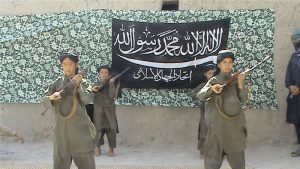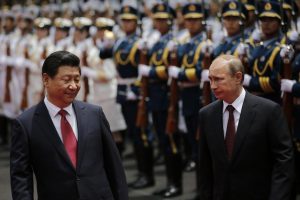The People’s Republic of Commodities and Central Asia
Brian M Downing
China recently opened a lengthy rail line winding from northern Afghanistan through Uzbekistan, Kazakhstan, Tajikistan, and Kyrgyzstan, and ending at the port city of Nantong. The line strengthens China’s position in Central Asia. The region is largely undeveloped, run by aging communist party bosses, and ripe for exploitation. What Africa was in the nineteenth century, Central Asia is today.
The PRC’s plans will not go easily. It’s a rough neighborhood and likely to get much rougher, especially as tens of thousands of Chinese come in with less than honorable intentions and with an overweening confidence in their nation’s superiority.
Afghanistan
 While the US and other ISAF powers tried to defeat the Taliban over the last fifteen years, the PRC was diligently acquiring the rights to Afghanistan’s copper, iron, oil, and rare earths. The deals were sealed by timely deliveries of money to the appropriate venal figures in Kabul. Some projects, however, have been put on hold.
While the US and other ISAF powers tried to defeat the Taliban over the last fifteen years, the PRC was diligently acquiring the rights to Afghanistan’s copper, iron, oil, and rare earths. The deals were sealed by timely deliveries of money to the appropriate venal figures in Kabul. Some projects, however, have been put on hold.
American businesses are concerned chiefly with supporting military and development operations, not with long-term private enterprise. US military efforts serve mainly to advance the PRC’s interests. India and Iran are smaller players in the game.
The Chinese railroad offers a northern export route for Afghan commodities. This will concern Pakistan as it had high hopes that Chinese commodities would exit south to the ports of Karachi and Gwadar, the latter being an impressive new terminus that China recently built. Impressive but underused.
China has thus far eschewed large projects in Pakistan, owing chiefly to the worrisome security situation. The Pakistani Taliban and Baluch separatists may break off parts of the country, or at least turn them into protracted no-go zones. China has also been cool to using Gwadar as a naval base, attractive though a facility near the Strait of Hormuz would be.
Instability in Central Asia
Exploiting Afghanistan, Uzbekistan, Tajikistan, Kyrgyzstan, and western China brings risk. Large swathes of the region are plagued by overpopulation and limited access to land and water. Government is weak and corrupt, leaving many areas ripe for lawlessness, separatism, and Islamist militancy.
The attraction of Islamism, and its most violent form, ISIL, will be magnified by economic growth. Income inequality will grow, as political and business elites benefit from Chinese investments. Indigenous sensitivities will not look kindly on the influx of foreign engineers and skilled workers.
Western China and Central Asia have Uighur populations, indigenous and refugee, who are deeply resentful of China’s development of their homeland in Xinjiang province. Uighurs have conducted several terrorist attacks in many parts of China. Most have been small in scale and rather amateurish, though resulting in many deaths.
 ISIL and al Qaeda in Syria, Iraq, and Af-Pak have attracted recruits from the ‘Stans. They are learning a growing trade and they will return to a restive population. Rapid development will enable militants to move about the region with greater ease.
ISIL and al Qaeda in Syria, Iraq, and Af-Pak have attracted recruits from the ‘Stans. They are learning a growing trade and they will return to a restive population. Rapid development will enable militants to move about the region with greater ease.
Security in the ‘Stans is largely in Russian hands. Moscow has conducted military operations in Uzbekistan and Tajikistan, and has a large airbase in Kyrgyzstan. The US is protecting Chinese investments in Afghanistan, Russia is doing the same in other parts of Central Asia.
The Russian-Chinese partnership
Russia, though closely aligned with China for the time being, is wary of Beijing and probably opposed to PLA troops in what Moscow refers to as the Near Abroad. Development in Central Asia and the Russian Far East presents long-term problems, mostly for Russia.
 China sees much of the regions as parts of the Middle Kingdom’s illustrious past which were taken away by powerful tsars in centuries past. China is a rising power – one that likely sees Russia as an overstretched country enjoying an illusory resurgence.
China sees much of the regions as parts of the Middle Kingdom’s illustrious past which were taken away by powerful tsars in centuries past. China is a rising power – one that likely sees Russia as an overstretched country enjoying an illusory resurgence.
Chinese corporations outnumber Russian counterparts by a wide margin. Engineers and skilled workers pour in from the southeast, often intermarrying with locals. Ethnic Russians express their anger to Moscow. They receive only calls for patience.
The Russian military, like most things in the country, has a degree of Potemkinism. Some units are well-equipped and highly-trained, others are not. The latter are garrisoned in Central Asia and the Russian Far East. Chinese economic hegemony is all but assured; political control is on the distant horizon.
Copyright 2016 Brian M Downing
Brian M Downing is a national security analyst who has written for outlets across the political spectrum. He studied at Georgetown University and the University of Chicago, and did post-graduate work at Harvard’s Center for International Affairs.